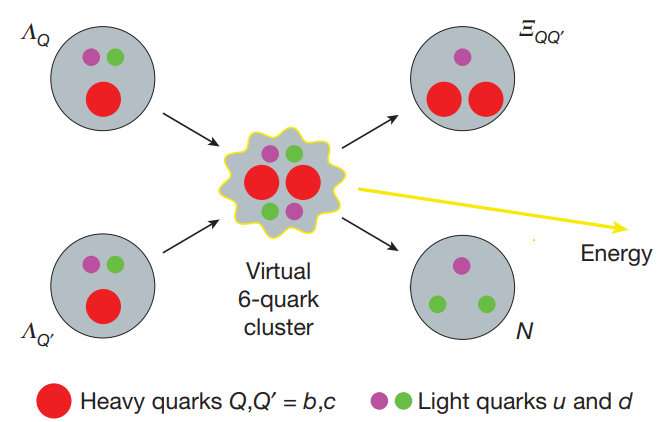November 6, 2017 report
Theoretical quark fusion found to be more powerful than hydrogen fusion

(Phys.org)—A pair of researchers with Tel Aviv University and the University of Chicago has found evidence suggesting that fusing quarks can release much more energy than anyone thought. In their paper published in the journal Nature, Marek Karliner and Jonathan Rosner describe their theories surrounding the amount of energy involved when various types of quarks are fused together.
To learn more about subatomic particles, researchers at the Large Hadron Collider cause atoms to move at high speeds and then smash them into one another. Doing so forces the component parts of the atoms to be disassociated from one another allowing each to be studied. Those components, scientists have found, are called quarks. Prior research has also shown that when atoms in the collider smash into each other, sometimes the pieces that come apart collide with other parts, fusing them into particles called baryons.
Prior work has suggested that energy is involved when quarks fuse together. In studying the properties of one such fusing, a doubly-charmed baryon, the researchers found that it took 130 MeV to force the quarks into such a particular configuration, but they also found that fusing the quarks together wound up releasing 12 MeV more than that. Intrigued by their finding, they quickly focused on bottom quarks, which are much heavier—calculations showed it took 230 MeV to fuse such quarks, but doing so resulted in a net release of approximately 138 MeV, which the team calculated was approximately eight times more than the amount released during hydrogen fusion.
Since hydrogen fusion lies at the heart of hydrogen bombs, the researchers were quite naturally alarmed at their findings. So much so that they considered not publishing their results. But subsequent calculations showed that it would be impossible to cause a chain reaction with quarks because they exist for too short a period of time—approximately one picosecond—not long enough to set off another baryon. They decay into much smaller, less dangerous lighter quarks.
The researchers point out that their work is still purely theoretical. They have not tried to fuse bottom quarks, though they note it should be technically feasible at the LHC should others find doing so a worthwhile experiment.
More information: Marek Karliner et al. Quark-level analogue of nuclear fusion with doubly heavy baryons, Nature (2017). DOI: 10.1038/nature24289
Abstract
The essence of nuclear fusion is that energy can be released by the rearrangement of nucleons between the initial- and final-state nuclei. The recent discovery of the first doubly charmed baryon Ξ++cc , which contains two charm quarks (c) and one up quark (u) and has a mass of about 3,621 megaelectronvolts (MeV) (the mass of the proton is 938 MeV) also revealed a large binding energy of about 130 MeV between the two charm quarks. Here we report that this strong binding enables a quark-rearrangement, exothermic reaction in which two heavy baryons (Λc) undergo fusion to produce the doubly charmed baryon Ξ++ cc and a neutron n (ΛcΛc →Ξ++cc n ), resulting in an energy release of 12 MeV. This reaction is a quarklevel analogue of the deuterium–tritium nuclear fusion reaction (DT → 4 He n). The much larger binding energy (approximately 280 MeV) between two bottom quarks (b) causes the analogous reaction with bottom quarks (Λ Λb b→Ξbbn 0 ) to have a much larger energy release of about 138 MeV. We suggest some experimental setups in which the highly exothermic nature of the fusion of two heavy-quark baryons might manifest itself. At present, however, the very short lifetimes of the heavy bottom and charm quarks preclude any practical applications of such reactions.
Journal information: Nature
© 2017 Phys.org




















